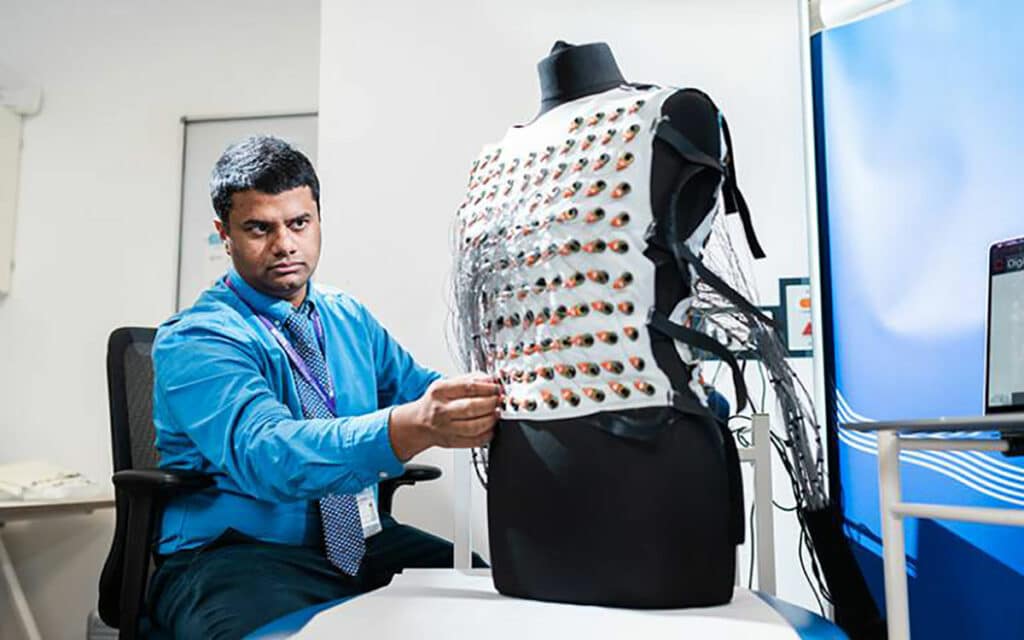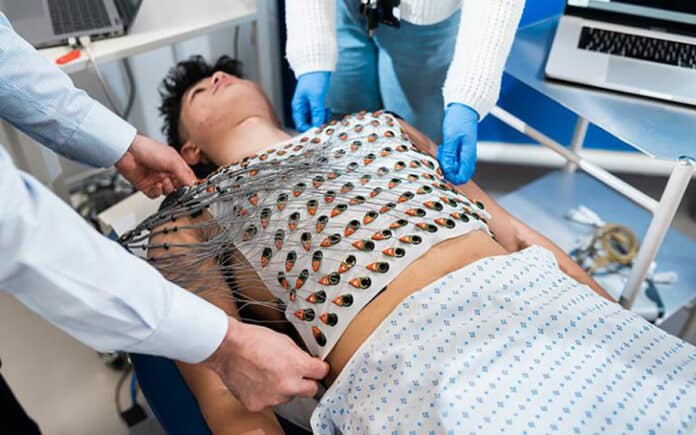University College London (UCL) researchers have developed an electrocardiographic imaging (ECGI) vest that has the potential to be used in standard care as it is reusable and time-efficient, with only five minutes needed per patient.
A new study led by UCL researchers suggested that the reusable vest that can map the electric impulses of the heart in fine detail could detect abnormalities from a potentially fatal heart disease much earlier than is currently possible.
Hypertrophic cardiomyopathy is a medical condition that affects the heart, where its muscle wall thickens and stiffens, reducing its ability to pump blood effectively throughout the body. Although it is estimated that one in 300 adults is affected by this condition, some individuals with genetic variants that cause the disease do not experience any symptoms.
However, hypertrophic cardiomyopathy can lead to heart failure, and it is often cited as the most common reason for sudden, unexpected death in young people.
“By finding subtle electrical abnormalities using our new technique, we are able to detect hypertrophic cardiomyopathy earlier,” said lead author Dr George Joy (UCL Institute of Cardiovascular Science and Barts Heart Centre). “This is important as it means we can potentially act earlier, providing new treatment to slow the disease as well as fast-tracking individuals to clinical trials that have the potential to stop the disease entirely.”

“Next steps of the research include repeating these results in a larger group of patients and following individuals over time to see how these early electrical changes affect the risk of life-threatening heart rhythms later on.”
The ECGI vest has 256 sensors that can provide detailed electrical mapping of the heart in just five minutes. This kind of mapping was previously rare and required invasive procedures or costly single-use devices.
The ECGI vest is reusable and has the potential to become a standard screening tool.
The researchers tested the vest technology on 174 patients who had genetic testing recruited from three London hospitals and 37 healthy volunteers. Patients included people who already had hypertrophic cardiomyopathy as well as individuals with disease-causing genetic mutations who did not have overt signs of the disease.
The team found that the ECGI vest could uncover electrical abnormalities in 25% of individuals with a gene mutation, even when standard cardiac imaging and ECG tests did not show any signs of disease. When the ECGI vest was used, these patients were found to exhibit an uneven pattern of electrical signal recovery and slowed conduction of electrical signals through the heart.
Additionally, the researchers developed a machine learning model to assess the severity of the disease and risk of sudden cardiac death based on the results of 12 markers from the ECGI vest. They found that this grading system matched the risk estimated using standard protocol, which takes into account factors such as age and certain structural features of the heart.
“The ECGI vest we have developed is expanding our ability to understand the electrical functioning of the heart and to assess more precisely people’s risk of developing life-threatening heart rhythms,” said Dr Captur, senior author of the latest study in a statement.
“People who have genetic mutations causing hypertrophic cardiomyopathy are monitored regularly and given advice around exercise. In some cases, this might be to reduce or stop any intense exercise. This prescription can have a huge impact on a person’s quality of life, particularly in athletes or young patients. By better understanding risk, we hope to avoid instances where people are given such advice unnecessarily.”
“While further research is needed, this study suggests that the ECGI vest, which collects far more detailed electrical signal data than a routine ECG, could support better identification of high-risk patients with hypertrophic cardiomyopathy,” added Dr Sonya Babu-Narayan, Associate Medical Director at the British Heart Foundation. “Some people living with hypertrophic cardiomyopathy are particularly susceptible to cardiac arrest. The ECGI vest could offer an opportunity for doctors to better diagnose them early in their disease course and target their treatment to prevent this.”
Journal reference:
- George Joy, Luis R. Lopes, Gabriella Captur, et al. Electrophysiological Characterization of Subclinical and Overt Hypertrophic Cardiomyopathy by Magnetic Resonance Imaging-Guided Electrocardiography. Journal of the American College of Cardiology, 2024; DOI: 10.1016/j.jacc.2024.01.006
